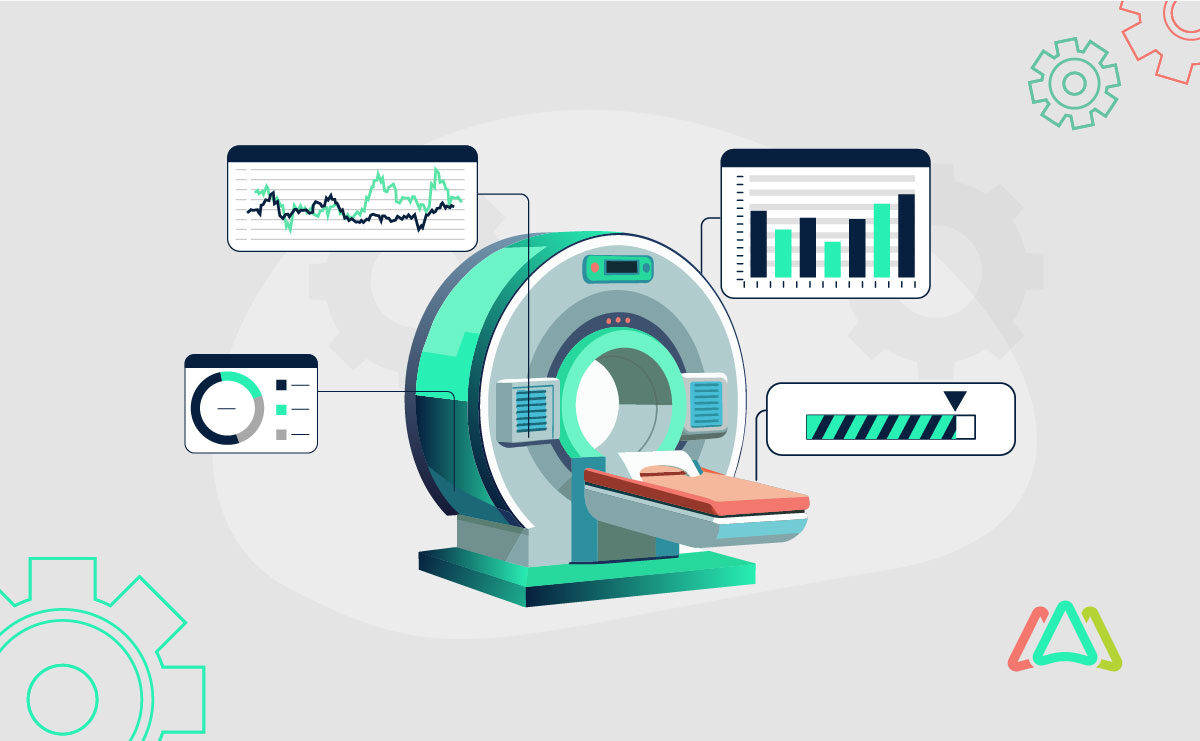
Precision in Healthcare - Leveraging Maintenance Analytics for Better Equipment Reliability
Picture a surgeon relying on an MRI machine to diagnose a critical condition, only for the machine to fail in the middle of a scan. The consequences could be devastating. A single malfunction can have life-threatening consequences, which is why it's so important for the equipment to be dependable. Precision and reliability in healthcare equipment are essential for patient safety and quality care. This is where Maintenance Analytics plays a key role, offering a data-driven approach that monitors equipment performance and enables healthcare facilities to predict and prevent potential failures. This article explores how Maintenance Analytics can enhance the reliability of medical equipment, helping healthcare providers deliver better, safer patient care through data-driven maintenance strategies.
What is Maintenance Analytics?
Maintenance Analytics is a data-driven approach that focuses on the discovery, understanding, and communication of maintenance insights using both historical and real-time data. It involves collecting data from various sources, such as sensors, equipment logs, and maintenance records, to inform decisions about equipment upkeep. By analyzing this data, healthcare facilities can predict failures, optimize maintenance schedules, and ensure that equipment operates efficiently and reliably.
There are four main types of Maintenance Analytics, each addressing different time-related perspectives:
Descriptive Analytics (Monitoring)
This focuses on understanding past performance by analyzing historical data to identify trends and patterns in equipment failures, downtime, and maintenance activities. It helps uncover what happened in the past.
Diagnostic Analytics
Going beyond just what happened, this type of analytics aims to understand why certain failures or malfunctions occurred, providing deeper insights into the root causes of issues.
Predictive Analytics
By analyzing real-time data from sensors and usage patterns, this approach estimates what might happen in the future. It forecasts potential equipment failures, allowing for timely, proactive maintenance to avoid disruptions.
Prescriptive Analytics
The most advanced form not only predicts failures but also suggests the best course of action. Considering factors such as cost, usage, and risk helps healthcare providers decide what needs to be done next for optimal maintenance.
How Maintenance Analytics Enhances Equipment Reliability
Reliable medical equipment is essential for effective patient care, and Maintenance Analytics is transforming how healthcare providers approach this challenge. By utilizing data-driven insights, facilities can proactively manage equipment performance and reduce the risk of failures. Here are ways Maintenance Analytics enhances equipment reliability:
Predictive Maintenance
Predictive Maintenance driven by maintenance analytics helps in detecting early signs of equipment failure by analyzing real-time data from various sensors and monitoring systems. By identifying patterns and trends, healthcare providers can address potential issues proactively, preventing unexpected downtime and ensuring critical equipment remains operational when needed.
Optimized Maintenance Schedules
Data-driven insights enable the development of optimized maintenance schedules tailored to actual equipment performance. This approach helps avoid over-servicing, wasting resources and time, as well as under-servicing, which can lead to increased risks of failure. By aligning maintenance activities with equipment usage patterns, healthcare facilities can improve both equipment longevity and overall operational efficiency.
Minimizing Human Error
Automation through Maintenance Analytics reduces reliance on manual processes, which can often lead to human errors. By automating routine maintenance tasks and utilizing analytics for decision-making, healthcare facilities can enhance accuracy and consistency. This not only boosts overall equipment reliability but also allows staff to focus on more critical tasks, ultimately improving patient care.
Enhanced Reporting and Analysis
Additionally, advanced analytics provide valuable insights through detailed reporting on equipment performance and maintenance history. This data helps identify recurring issues and informs future maintenance strategies, contributing to a continuous improvement cycle.
Continuous Learning
The integration of Maintenance Analytics promotes a culture of continuous learning within healthcare organizations. By regularly reviewing data and maintenance outcomes, facilities can refine their strategies and enhance overall operational excellence.
In summary, Maintenance Analytics significantly improves equipment reliability by predicting failures, optimizing maintenance schedules, automating tasks, and providing actionable insights. This ensures better patient care, minimizes disruptions, and ultimately leads to a more efficient healthcare environment.

Key Benefits of Maintenance Analytics in Healthcare
As healthcare facilities face increasing demands for efficiency and reliability, Maintenance Analytics emerges as a transformative solution. By leveraging data-driven insights, organizations can significantly enhance their operational performance while improving patient safety and care quality. Here are the key benefits:
Cost Efficiency
Implementing Maintenance Analytics through predictive and prescriptive maintenance strategies leads to substantial cost savings. By accurately forecasting potential equipment failures, healthcare facilities can prevent costly breakdowns and avoid unnecessary servicing. This proactive approach not only optimizes maintenance budgets but also enhances resource allocation, resulting in more cost-efficient healthcare operations.
Enhanced Safety
The integration of Maintenance Analytics significantly reduces the risk of equipment failure, ensuring that critical medical devices are reliable when patients need them most. This proactive maintenance strategy nurtures safer healthcare environments for both patients and staff, minimizing the likelihood of accidents or delays that can jeopardize patient care.
Prolonged Equipment Lifespan
Data-driven maintenance practices are instrumental in extending the lifespan of essential medical equipment. By continually monitoring performance and addressing issues before they escalate, Maintenance Analytics helps reduce wear and tear. This not only ensures optimal performance but also contributes to the longevity of equipment, maximizing the return on investment for healthcare facilities.
Improved Compliance and Reporting
Another key benefit is the enhanced ability to meet regulatory requirements. Maintenance Analytics provides comprehensive data that aids in compliance reporting, ensuring that facilities adhere to industry standards and guidelines.
Overcoming Challenges in Implementing Maintenance Analytics
While the benefits of Maintenance Analytics are substantial, implementing these systems in healthcare settings can present several challenges. Addressing these obstacles is important for maximizing the potential of analytics to improve equipment reliability and operational efficiency. Here are the key challenges and strategies for overcoming them:
Data Integration
Integrating Maintenance Analytics into existing healthcare systems can be difficult due to different data formats and equipment compatibility issues. To overcome this, healthcare facilities need to invest in tools that facilitate seamless data collection and integration, ensuring all systems work together efficiently.
Staff Training
Proper implementation of Maintenance Analytics requires well-trained technicians and healthcare staff. Comprehensive training programs are essential to ensure that employees can effectively use and interpret the analytics tools, enabling them to make informed decisions about equipment maintenance.
Regulatory Compliance
Navigating healthcare regulations around data collection and maintenance analytics is critical. Healthcare facilities must ensure compliance with industry standards to protect patient data while optimizing maintenance processes. This includes adhering to strict protocols for data security and privacy.
By addressing these challenges, healthcare providers can fully leverage Maintenance Analytics to improve equipment reliability and operational efficiency.
The Future of Maintenance Analytics in Healthcare
As the healthcare industry evolves, the role of Maintenance Analytics is expected to grow significantly. Emerging technologies are set to revolutionize how healthcare facilities manage equipment maintenance, leading to improved patient outcomes and operational efficiency. Here are some key trends shaping the future of maintenance analytics.
AI and Machine Learning
Artificial intelligence (AI) and machine learning are set to revolutionize Maintenance Analytics by enhancing predictive maintenance capabilities. These technologies can analyze vast amounts of data to predict equipment failures with greater accuracy, allowing for even more proactive maintenance strategies.
Smart Equipment and IoT
The integration of smart medical devices and the Internet of Things (IoT) will enable real-time analytics. These connected devices can continuously monitor equipment health and send data directly to maintenance systems, enabling instant insights and faster responses to potential issues.
Scalability
As healthcare infrastructure grows, Maintenance Analytics will become more scalable, allowing facilities of all sizes to manage their equipment more efficiently. A healthcare CMMS will help achieve scalability. This will lead to improved healthcare delivery by ensuring all medical devices are consistently reliable and well-maintained.
Conclusion
Maintenance Analytics plays a vital role in improving the reliability of healthcare equipment. By leveraging predictive and data-driven maintenance strategies, healthcare facilities can reduce downtime, extend equipment lifespan, and enhance overall safety. The integration of real-time analytics and automation also minimizes human error, ensuring critical medical devices function when they are needed most.
Embracing data-driven maintenance strategies is essential for improving healthcare outcomes. With advancements like AI and IoT, facilities can stay ahead of equipment failures and maintain higher operational efficiency.
Healthcare professionals are encouraged to explore Maintenance Analytics solutions to optimize equipment performance, enhance patient safety, and drive long-term efficiency.
TABLE OF CONTENTS
Keep Reading
Ever find yourself checking into a luxury hotel and expecting a relaxing stay, only to find a ...
11 Apr 2025
Organizations are witnessing swift changes in the business environment and confronting a ...
8 Apr 2025
Last month, news outlets and the entire internet was abuzz with the return of NASA astronauts ...
3 Apr 2025
What comes first - CMMS or predictive maintenance? If your answer is either, it is correct. ...
28 Mar 2025
Artificial intelligence (AI) talk has become commonplace. Today, engaging in business-focused ...
27 Mar 2025
Imagine a world where machines predict, diagnose, and fix their issues before they fail. This ...
25 Mar 2025
A facility maintenance plan is at the core of a facility’s operations. This organized ...
21 Mar 2025
Think of managing your maintenance operations like managing a championship sports team. Just ...
21 Mar 2025
The maintenance sector is battling a severe talent shortage that threatens to undermine ...
7 Mar 2025
Manufacturing maintenance is the backbone of industrial efficiency, ensuring machines run ...
5 Mar 2025
No one likes playing a guessing game when equipment breaks down. Yet, maintenance teams often ...
4 Mar 2025
The size of the preventive maintenance software market is discussed in millions of dollars, ...
4 Mar 2025
The organizational structure and corporate hierarchy vary from company to company. Large ...
28 Feb 2025
Maintenance procedures are essential for ensuring the longevity and reliability of machinery ...
21 Feb 2025
Sustainability is no longer just a buzzword; it's a critical component of corporate social ...
20 Feb 2025
A Computerized Maintenance Management System (CMMS) relies on accurate, well-organized data ...
18 Feb 2025
In an era where technology drives operational efficiency, Computerized Maintenance Management ...
14 Feb 2025
A Computerized Maintenance Management System (CMMS) is a key component of modern maintenance ...
13 Feb 2025
Introduction Maintenance management is the foundation of maintenance operations in industries ...
11 Feb 2025
Introduction A Computerized Maintenance Management System (CMMS) is software designed to help ...
7 Feb 2025






